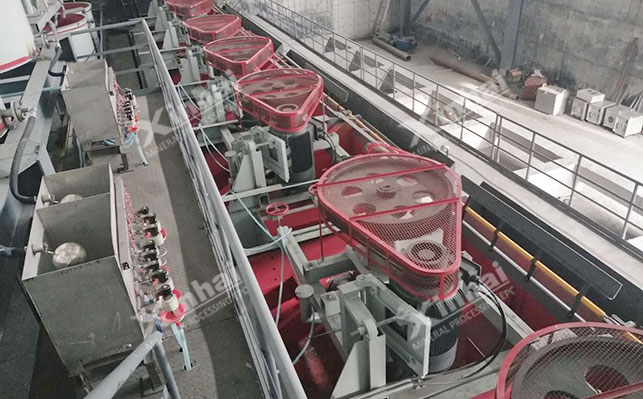Fluorite, also known as fluorite, is an important non-metallic mineral resource. There are various types of fluorite ore, each with different properties and characteristics, and different beneficiation methods.
A single fluorite mine is almost composed of a single fluorite mineral, containing a small amount of quartz and calcite, and is mostly produced in vein like form. Colors include light green, white, purple, etc., with a glassy luster. Due to the limited variety of ores and high fluorite content, ideal fluorite concentrate can be obtained by conventional flotation. Adopting a stage grinding and flotation process, discarding tailings as early as possible to improve the selected grade, reduce over crushing, and increase recovery rate. Fatty acid reagents are used as collectors during flotation, and water glass is used as suppressants.
The main minerals are fluorite and quartz, with fluorite content reaching 80% to 90%, containing small amounts of calcite, barite, and sulfides. High hardness, mostly white or gray in color. Due to the differences in physical properties between quartz and fluorite, they can be separated by flotation. Adopting a process flow of one-time grinding and coarse selection, followed by repeated refining of coarse concentrate, the pH value is adjusted to 8-9 using sodium carbonate as an adjusting agent to prevent the activation of quartz by multivalent cations. When using fatty acids as collectors, water glass is added to suppress quartz. However, high quartz content will increase the complexity of mineral processing, and it is necessary to adjust the process parameters reasonably.

The main minerals are fluorite and calcite, with a calcite content of over 30%, as well as sulfides. The color is mostly white or light yellow, with a certain glossiness. Calcite and fluorite have similar properties, making mineral processing difficult. Under alkaline conditions, it is common to conduct one coarse selection and one sweep selection, while under acidic conditions, it is recommended to conduct multiple selections and return the intermediate ore to the flotation process in sequence. Roughly select oleic acid+oxidized paraffin soap as the collector, sodium carbonate as the pH adjuster, water glass+sodium hexametaphosphate as the inhibitor, and select sulfuric acid+water glass+LP as the inhibitor.
The main minerals are barite and fluorite, with barite content ranging from 10% to 40%. Barite and fluorite have similar properties and are difficult to separate. They can be initially separated by reselection before flotation. For barite fluorite type ores, oleic acid is generally used as a collector and water glass is used as an inhibitor for mixed flotation. Then, dextrin or tannin with iron salt is used to suppress the flotation of barite fluorite, or alkyl sulfate is used to flotation barite to retain fluorite concentrate.
Sulfides coexist with fluorite, with complex composition and high difficulty in mineral processing. During mineral processing, first use yellow medicine collectors to float the sulfide ore, and then add fatty acid reagents to the tailings to select fluorite multiple times according to the fluorite selection process.
Fluorite is distributed in fine-grained form in siliceous rocks and coexists with quartz and other minerals. Easy to distinguish, using a one coarse and multiple fine sweep flotation process, coarse selection recovers most of the fluorite minerals, fine selection improves grade, and sweep selection recovers lost minerals.
Fluorite is distributed in fine-grained form in limestone and marble, coexisting with calcite and other minerals, making it difficult to distinguish. Generally, mixed flotation is carried out first, and then fluorite and calcite are separated. When using fatty acids as collectors, high-temperature pulping treatment and the addition of calcium inhibitors are required, resulting in high costs. If oxide collectors and NaF are used together or with dispersants, flotation can be carried out at lower temperatures.
The properties of different types of fluorite ores vary, and process selection is particularly important in actual beneficiation plants. Suggest conducting beneficiation tests on fluorite and tailoring suitable beneficiation processes for it.